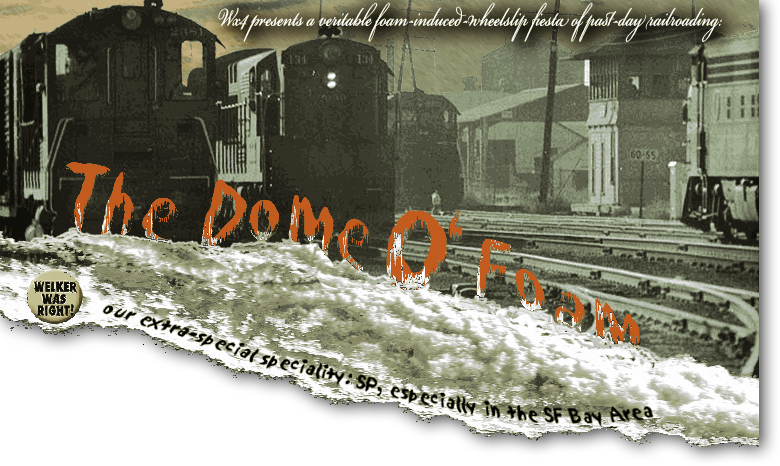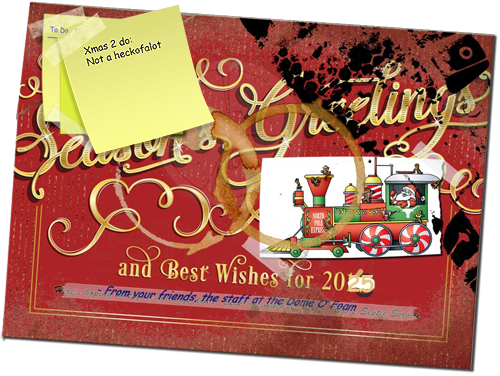 |
 NEW ARRIVALS See the Dome Blog at right NEW ARRIVALS See the Dome Blog at right
 Southern Pacific Pages Southern Pacific Pages
mmmmm m master directory to SP items, including,
mmmmm m but not limited to the following:
xxx The Ernie Kiesel Collection of Southern xxxPacific Photographs at History San Jose The Ernie Kiesel Collection of Southern xxxPacific Photographs at History San Jose
xxxxxxlargexphoto collection of enginemen, plus
xxxxxxbiographic info
xxx Southern Pacific Historical Maps & Southern Pacific Historical Maps &
xxxTimetables - Now, all SP items from the Wx4
xxxxxxHistorical Maps & TT pages in one spot!
xxx Southern Pacific Railroaders'.Pages Southern Pacific Railroaders'.Pages
xxxxxxindex to pages devoted to veteran SP'ers
xxx Southern Pacific steam loco appliance Southern Pacific steam loco appliance
xxxdrawings 100+ rescued by Fred Boland
xxx Southern Pacific right-of way & xxxstructure drawings SP-drafted, incl. SPINS, Southern Pacific right-of way & xxxstructure drawings SP-drafted, incl. SPINS,
----- - -100+ engineering drawings
xxx SP San Jose & Santa Clara Valley SP San Jose & Santa Clara Valley
.........SHORTCUT to our "meat & potatoes"
 The Past Less Traveled a cornucopia of The Past Less Traveled a cornucopia of
xxx19th & early 20th Century RRing
 Historical Maps & Timetables pages Historical Maps & Timetables pages
....well over 7,000 PDF's from several kind
xxxxpeople
 Railroad & Industry Rules Railroad & Industry Rules
----rule books, regulations
 Miscellaneous Ry. Documents Miscellaneous Ry. Documents
----Now, several pages of sundry docs,some odd Large Railroads Large Railroads
----class one lines
 Shortline Railroads Shortline Railroads
----the little guys
 Miscellaneous Photos Miscellaneous Photos
xxxrandom photos that we just plain like
 Silly Johnny Silly Johnny
---the train wreck that sometimes was RR ads,
xxxas reviewed by jaded retired RRer
 [Rail] Roadside America [Rail] Roadside America
---Route 66, railroad-style
 The Harmonic Convergence of Jeeps and xxxGeeps - evidence that Wx4 started out as a The Harmonic Convergence of Jeeps and xxxGeeps - evidence that Wx4 started out as a
----- - -Willys Jeep Wagon website
 The Harmonic Convergence of The Harmonic Convergence of
----Jeeps and Geeps - very strange evidence that
xxxxxxWx4 started out as a Willys Jeep Station
xxxxxxWagon website
 Wx4 Grab Bag futile attempts at humor; Wx4 Grab Bag futile attempts at humor;
xxxxxxReal RR Stories; commentary;odds n' ends
 Taking Stock of William Jennings Taking Stock of William Jennings
xxxHolman and His Improbable Locomotive - 30K
xxxxxxword magnus opus to one of the 1800's
xxxxxxgreatest conmen & his loco - See also:
xxxxxxBlowing Smoke, Francis J. Doyle and His xxxxxxDoylair Smokeless Locomotive
 Questions for People with Answers Nagging questions that have baffled Staff Questions for People with Answers Nagging questions that have baffled Staff
|
|
|
|
|
The Ernie Kiesel Collection of Southern Pacific Photographs at History San Jose - Wx4 is proud to host this genealogical treasure of 300+ photos that once lined locomotive engineer change room walls in San Francisco circa 1900-1980. Engineers and their locos are the main subjects, but other crafts and officers are also represented, as are wrecks and other historical moments. Includes a biographical index to known people. |
|
|
Jawbone Dispatching Comes to Tucumcari - In 1984, Staff spent 28 hours on a freight train attempting to make it over the road on SP's Carrizozo Subdivision, while the line still was dispatched using train orders. Then a miracle happened:SP replaced TO's with Direct Traffic Control. Now even the dog trains began to make it over the territory within Hours of Service.- several pages; also, related Train Order Primer (with Final Exam), Direct Traffic Control Explained and a short course on How to Call the SP Dispatcher (danger lurks!) |
|
|
Southern Pacific Railroaders' Pages - We are fond of saying that, "The best part of railroading is the people," and these pages are devoted to them: biographies and stories; photos and videos; time books and rosters. Our pages and the Kiesel Collection nicely compliment each other. |
|
|
52 Years in the Shops - Speaking of SP rails, during his notably lengthy employ as a machinist at Bayshore beginning in 1929, Fred Boland wrote a fair number of stories about his work - and took a lot of photos, some as early as 1927. Along with these are more than 100 steam loco appliance & etc. blueprints that he rescued from the dumpster after dieselization. Fred's son, Walter, has kindly contributed copies his father's collected works to Wx4. |
|
|
Historical Maps & Timetables 7,000+ maps and employee/ public timetables from most areas of North America, maybe 400-500 railroads. In 2024 we created one stop shopping for Combined SP Maps & TT's by mirroring all of Wx4's SP offerings on one page. Likewise we have folded our Rule Book, SP employee rosters amd Miscellaneous Documents pages into the Maps & Timetables section. |
|
|
Taking Stock of William Jennings Holman and His Improbable Locomotive - Much of what you know about one of the more famous stock schemes of the 19th Century, The Holman Locomotive, and its perpetrator is wrong; is the product of what Wx4 labels as "Internet Cut & Paste History". Our 30,000 word magnus opus sets things straight, by delving into his life as a long time confidence man and inventor who demonstrated remarkable resiliency after repeated failures with a rainbow of improbable schemes. Also, check our our homage to him. |
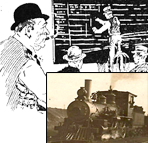
 HEY MID-WESTERNERS!:Staff honestly would pay a pretty penny for a circa 1901-1923 Doylair or Doyle Air Burner parlor stove. HEY MID-WESTERNERS!:Staff honestly would pay a pretty penny for a circa 1901-1923 Doylair or Doyle Air Burner parlor stove.
|
NEW 3-1-25: Blowing Smoke, Francis J. Doyle and His Doylair Smokeless Locomotive - FJ Doyle showed more practicality than WJ Holman (above) in his inventions, but much less criminal talent. This he left to the fabulous Wood brothers, boy wonders who built a "bucket shop" empire of 150+ offices in two years time before injecting themselves into Doyle Air Burner Company, causing it to go bankrupt. Undaunted, Doyle fitted up his Smokeless Locomotive in 1910: a total flop. He did produce successful parlor stoves under the Air Burner and Doylair brands. Wx4 Staff would truthfully pay big money for one of these. Bonus: This tale is less than 1/3 the length of the Holman story! |
|
|
Wreck of the New Almaden Mixed - In 1902, this South Pacific Coast narrow gauge train fell victim to a cornfield meet with a standard gauge SP engine in the fog at Moulton, on the three rail SPC main near Campbell. This lengthy piece thoroughly covers the affair and includes previously unpublished photos. Coincidentally, Moulton was the namesake of the man who had pressured SPC into adding a third rail several years earlier. His biography is also included. |
|
|
California & Oregon Coast RR, incl. Hobbs, Wall & Co. and other Del Norte County RR's - The lengthy title befits this large page, which first appeared in Wx4's earliest days, and has since benefitted from many contributors. Here you'll find lots of photos and maps of these obscure little railways, as well as rosters that correct errors found in commercial print sources. |
|
|
Paducah's Boneyard and the Fate of IC's Last E-units - Classic Trains magazine's Spring, 2023 issue features "Firing on the Illinois Central in 1969", an article describing Mike Einhorn's brief, but scrapes-laden career as a student fireman. Mike's experiences went a long way in sideways explanation of conditions and attitudes that caused IC to have so many wrecks, something we discovered 15 years ago while producing our Paducah page. We figured then that IC wrecks turned fully 16% (10) of its E-Units into scrap metal. Otherwise, you'll note lots of photos of a wide variety of IC/foreign units. |
|
|
Southern Pacific Train # 308 w/ Engine #1714 at Willows, CA, 1910-11
Years back we were gifted with a photo showing SP train #308 and crew standing at an unknown location. Of course we wanted to know where and when, so after we placed a plea on Wx4, the late Ed Workman determined the approximate date of the photo, while the late Tony Johnson was able to figure out that the train was the Hamilton [City] Freight and Passenger pausing at Willows. From there, we were able to determine the exact spot on a Sanborn map where the engine was sitting. We sorely miss Ed and Tony. |
|
|
Earl Hanson and His SP Ditcher Gang, Circa 1916-1936
Earl and his gang worked all over the Portland and Shasta Divisions, including a considerable amount of time spent prepping the Cascade Cutoff right of way - Photo & biographical coverage |
|
|
Wx4 Looks at the Particulars of Baggage Smashing
At one time baggagemen, a.k.a. "baggage smashers" considered the desruction of baggage to be an art form: Wx4 investigates. |
|
|
|
|
 A Wx4 Staff Pick: A Wx4 Staff Pick:
|
|
It is easy to miss smaller publications about SP, so we wish to point out an exceptionally well done booklet by stalwart Wx4 friend Steve Donaldson. His Southern Pacific Comes to Coos Bay covers Willamette Pacific's construction of the Coos Bay Branch, through its later years as an independent railroad. It is an absolute must have for any SP in Oregon fan.
28 pages, with photos from the late Tom Dill's Collection; $10 plus postage:
Oregon Coast Historical Railway
766 First Street
Coos Bay, OR 97420
http://orcorail.org/
|
|
|
|
At Internet Archive: a nearly complete collection of
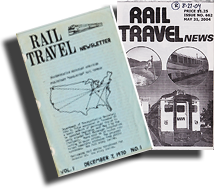
Rail Travel Newsletter, courtesy of the considerable efforts of its former Editor-at-Large, Paul Rayton, who is the sole surviving original staffer
|
|
|
|
|
For nearly 25 years, The Dome's staff has resisted change, despite a reader labeling Wx4 as being "superannuated" (yes, we looked up the word) way back in 2008. All these years later we now assess that WX4 has become 'superDOOPERannuated'. Thus, we allow that we should make at least a small nod towards modernity.
Accordingly - although we passionately hate the word, and its implicit regimented format - we have caved in and have turned the front page into a 'blog' to better conform to the lifestyle of today's foamer.
You're welcome! - Staff
 Items removed from this page into the interior: You shall find links to them HERE. Items removed from this page into the interior: You shall find links to them HERE.
|
| 12-20-25: Eagle Mountain Railroad and a Bit of SoCal Southern Pacific |
| Admittedly, Southern California tends to get short shrift on Wx4, so Staff is delighted that Jeff Moore has sent us twenty Charles Heimerdinger photos, plus related commentary, showing Kaiser ore trains on its former Eagle Mountain Railroad (think: Baldwins) and SP's Sunset Route in the 1950's and 1960's.
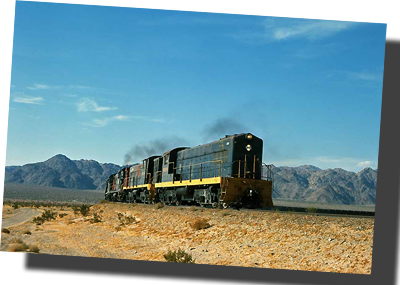
|
| 12-20-25: More timetables & a couple of maps |
Cards84664 has forwarded 68 more public timetables, mostly Amtrak and Conrail from the 1970's, but also some New York Central from the 1920's and 1930's, as well as a few from other railroads.
Tim Zukas has added 18 Illinois Central employee timetables, plus 1941 and 1952 Pacific Electric system rail/bus maps to his page.
|
| 12-17-25: 1920 LA terminal & Crossing studies |
| A must read for LA railroad history buffs:
Michael Lowe recently sent us a heads-up about an intriguing a 644 page 1920 California Railroad Commission document that he found in Google Books, entitled Railroad Grade Crossing and Terminal Investigation Los Angeles.
As the title suggests, it is comprised studies looking into the reduction railroad grade crossings in downtown LA, as well as investigations upon constructing a new union passenger terminal. Beyond the mounds of information - including a history of LA railroads -the volume includes several score of photos and nearly 90 maps and other drawings. Unusual for Google is that many of the maps were scanned in color at reasonably high resolution.
Looking at this volume sends one down the rabbit hole, so what Staff has done is separate the photos and maps into separate files at original resolution, along with creating a 36 meg reduced size copy of the original 88 meg behemoth. Hopefully this will make things more manageable.
Railroad Grade Crossing and Terminal Investigation Los Angeles - low resolution
Maps - original resolution
Photos - original resolution

|
| 12-16-25: Heimerdinger SP photos and a HUGE map |
We have created a dedicated page for Jeff Moore's collection of Charley Heimerdinger color 1950's-60's SP photos, which now includes the new "SP Steam at Closing Time" devoted to the San Francisco Peninsula (plus a smattering of Western Division and NWP) in the months either side of steam's demiset. Next will be a bunch of Eagle Mountain RR in Baldwin Diesel days.
Tim Zukas has dropped another fascinating map on us, this time a 14,000+ pixel wide 1914 map of the Oakland & Antioch Ry. (Sacreamento Northern) between Oakland and Bay Point. Tim reports that the original was about 30 feet long!
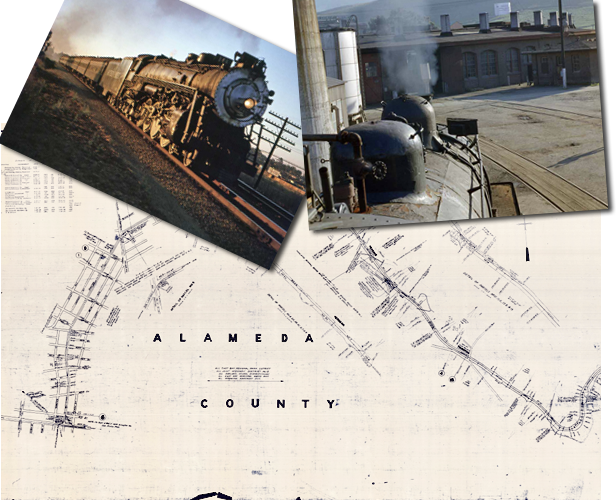
|
| 12-10-25: More "Badges?", plus other odds & ends |
| Sheldon Perry has forwarded a 1940 FC Inter-California ETT that shows the SD&AE section of the Golden State Ltd.
New to the Miscellaneous Documents page is a 100 page, August, 1994 edition of SP Mechanical Department's "Locomotive Data Book" (think: diesel roster for SP, D&RGW, SSW).
 |
Some time ago Staff posted a page of commentary regarding various badges and pins that SP put out over the years that in retrospect, failed to achieve their intended purposes. Here are some more: |
|
|
Staff has never encountered one of these before, but we figure that this was a Mechanical Department ID. The institutional appearance of the badge suggests that SP was indeed a family - a crime family. A couple of SP rails that we knew occasionally spent time in jail in between switching boxcars. Did these badges also function as prison ID's? |
|
|
As near as we can tell, this rather startling Action Comics style button appeared in the mid-1980's to promote some long-forgotten trains on the T&L lines.
Now who in the hell would wear one of these things without a gun held to his head? Traffic Department guys were not exactly Versace models, but they had their pride, after all. We can see a customer uttering the F-word under his breath as an SP salesman walked through the door wearing one of these babies.
This image was contributed by a guy who wishes it to be firmly known that this button pre-dated his tenure as an SP graphic design contractor. |
|
|
This button is the most attractive SP button that staff ever encountered. It advertised a 21st Century band whose members probably had never heard of the Southern Pacific Railroad. |
|
| 12-9-25: J. R. Signor's new San Joaquin Division book |
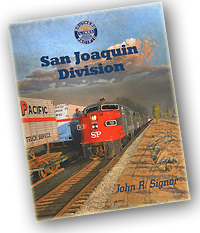 |
John Signor has been turning out railroad history books, mostly about Southern Pacific, for 44 years. His San Joaquin Division published by the Southern Pacific Historical & Technical Society represents his latest effort - his 20th.
A measure of his abilities is that his very first one - Rails in the Shadow of Mt. Shasta - inspired me to give up my trainman's seniority in favor of going firing in Dunsmuir. Now we have a massive 584 page work showcasing his enormous innate talents as a writer, historian, artist , graphic designer and cartographer that have been seasoned over a lifetime. Color photographs and his maps abound, well worth the price of the book by themselves. John says that his time working out of Tracy included some of his most enjoyable moments on SP, something that is very apparent in his coverage of the division's later days. San Joaquin Division is his finest work and likely his last SP book. - EO
|
|
| 12-8-25: more timetables |
Tim Zukas has forwarded ten 1900-1953 CStPM&O (C&NW) employee timetables, while on 12-06-25 Jeff Asay filled in a gap in Sheldon Perry's Sacramento Northern ETT's .
|
| 12-8-25: The Lunch Lizzy |
You've heard of "Tin Lizzie" in reference to a Ford Model T, but few people nowadays understand exactly what a "Lizzie" was during the early Twentieth Century, other than somebody's nickname. Lizzie also was popularly applied to female dray horses, and more generally served as the vernacular for any sort of humble conveyance, hence its adaption to the Model T.
Another example is the "Lunch Lizzie" that served hungry nighttime passengers at SP's Sacramento Depot in 1920. At the time, SP claimed to have more [money losing] dining cars in service than any other railroad, so SP believed in keeping passengers fat and happy, no matter the cost. Although it appears to be a wagon, the superstructure is actually fitted onto a Ford chassis, making Lunch Lizzy an inevitable choice for a name.
The original black & white image comes from the May, 1920 issue of the Southern Pacific Bulletin. The AI-generated colors are speculative. (click on image for larger version)
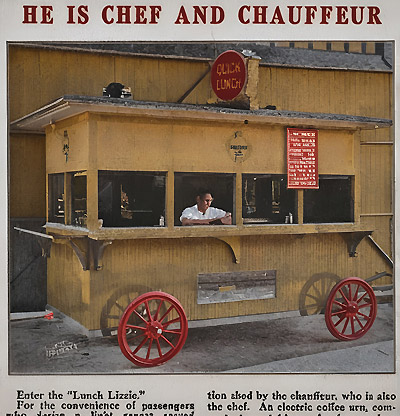
|
| 12-6-25: More 1970's SP in the Bay Area photos from Paul Noble |
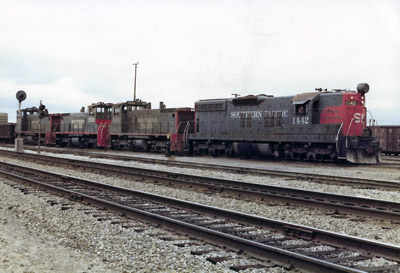
BSWJY pulling through San Jose Yard
PLUS, Paul solved one of our our "Questions for People with Answers" by nailing down the date of the SP San Jose wreck (in January, 1986, as it turns out) that spilled lumber all over Monterey Road and back yard swimming pools. Sadly, the engineer of the train, Lee "The Bullet" Barnett passed away early last year.
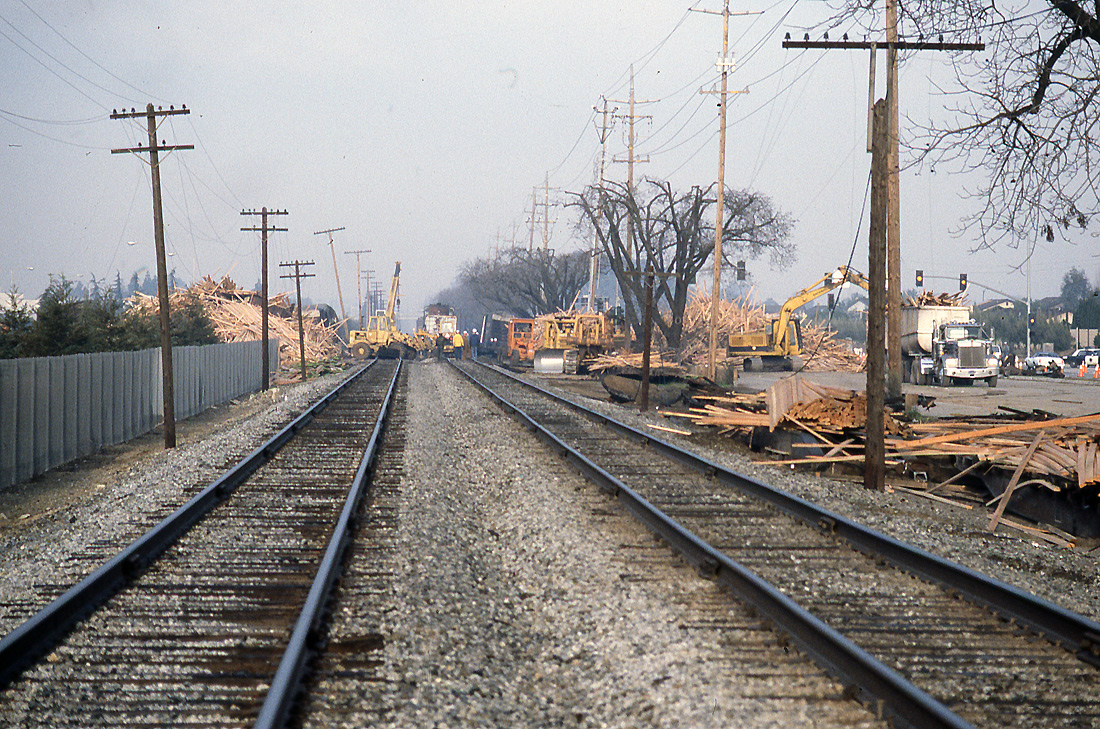
|
| 11-11-25: Another SP motive power restrictions map |
On 9-28-25, we posted a Coast Division motive power restictions map (below), and now here is another one of the same 1-1-1935 date, this time for the san Joaquin Division. It's format is a bit dirrenet in that it lists "allowable" classes, but our confusion about E-class 4-4-0's remains. They are not mentioned at all, even though most of SP's remaining 4-4-0's of the time resided in the San Joaquin Valley. Note that switch engine classes are not mentioned either (as with the Coast map).
Click on the image for the full map.
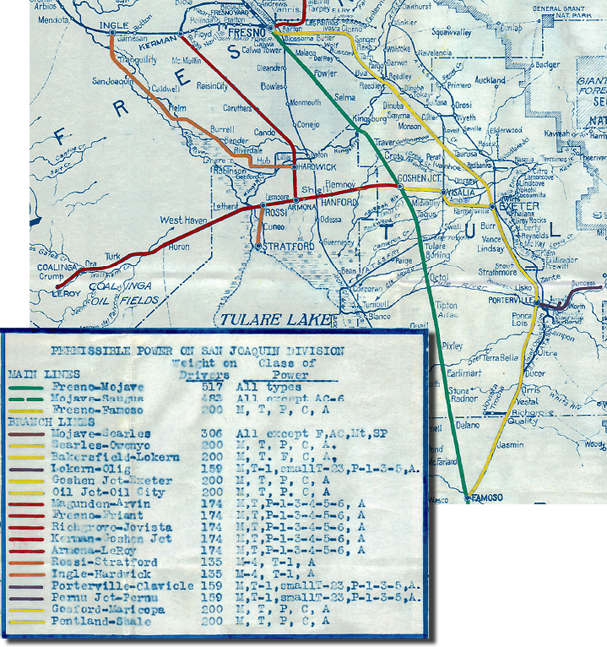
Shasta Division Archives
|
| 10-8-25: A Southern Pacific in "Greater New Jersey" map + 16 C&O ETT's, 1918-1954 |
Michael Sullivan recently sent Wx4 the URL to his "Greater New Jersey Railroad Map" at Google that has grown beyond its bounds as a work in progress over the last several years - to the point that it now includes all of the U.S. and Mexico. Now it is beginning to creep into Canada. It is incredibly useful in sorting out railroads in regions that formerly featured route structures that resembled spaghetti, such as Indiana. As you might guess, his map started out covering its namesake, but evolved into something more ambitious. He says that he did not "have the heart" to change its name and that it has been an inside joke. Well, the last time we checked, his map had 280,000 hits, so it may no longer that category. Note: It may take awhile to load.
Tim Zukas never goes very long without furnishing us with new employee timetables, does he?. This time around he has further populated his Maps & Timetables page with 16 Chesapeake & Ohio Railroad PDF's, circa 1918-1954. |
| 9-28-25: Further reorganization, plus a mystifying Coast Division map |
We have reorganized our SP Index page to make it less bewildering to navigate. That's all that we have to say about that.
One of our Questions for People with Answers:
xxxxxxxx'What gives' with this mystifying 1935 Coast Division "Motive Power Restrictions" map?
These clippings come from one of the more interesting SP maps that we have run across lately. It appears to be a paste-up for reproduction, because the legend seen here was literally pasted onto the map. More remarkable is what it in essence says: SP's 4-4-0's were banned from Coast Division branch lines, save Tres Pinos and Surf. Frankly, Staff is stumped as why this was so, especially given that, by this time, SP's 4-4-0 roster consisted of a handful of E-23's, mostly assigned to San Joaquin Valley branch lines and secondary passenger runs. The ban was almost a moot point. So, what gives?
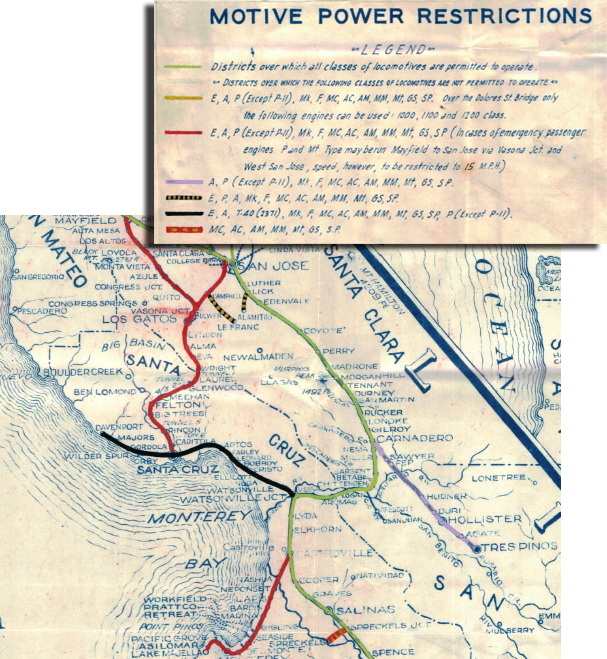
Shasta Division Archives
|
| 9-25-25: Wx4's Card Catalog ('your guide to everything Dome') moves to this page |
| Over the course of nearly 25 years, The Dome has grown to nearly impenetrable dimensions, something that we recognize. Now, in our second attempt at making access easier (the first being this blog), we have moved the contents of our virtual Card Catalog (aka: index) to column left.
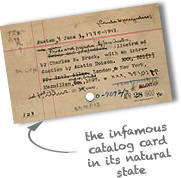
|
| 9-21-25: North Shore Timetable #13, the "Earthquake Edition" - and other stuff from Tim Zukas |
Perhaps some North Shore Railroad (later: North Pacific Coast; NWP) men were a bit trepidatious about the prospect of working under new employee timetable #unlucky 13. Sadly once it took effect, it immediately confirmed the worst of their superstitions. Take a look at the date and time. It went into effect exactly two hours and twelve minutes before the Great San Francisco Earthquake struck the Bay Area.
The railroad's one stroke of good fortune was that no passenger trains were out running on the line at the time, something which surely averted disaster. Train #7, which was due to leave Point Reyes for Sausalito an hour later, was unceremoniously dumped on its side, nevertheless. reportedly, no trains ever ran under timetable #13. Likewise, the two round trips to Cazdero carded in the timetable never materialized. By the time the line reopened under (presumably, timetable #14), management had judged that, as before the quake, one round trip to Cazadero would suffice.
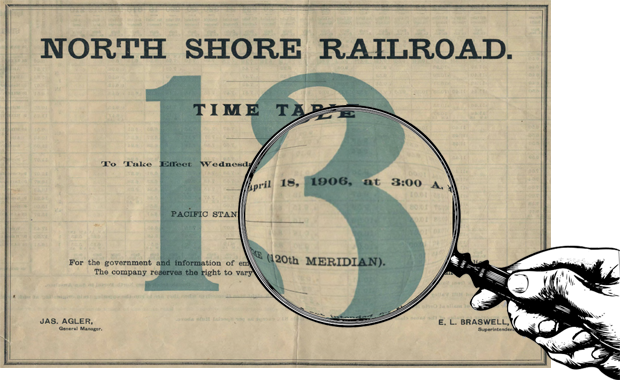
Employee timetable #13 comes to us courtesy of Tim Zukas, who has likewise supplied us with a copy of a public timecard for that date. He also has lately forwarded nearly a hundred timetables (Midwest, East, South, Canada), all of which are now online on his Maps & timetables page.
|
| 9-19-25: Yet more vintage SP maps + Coast Division Miscellany |
|
Coast Division
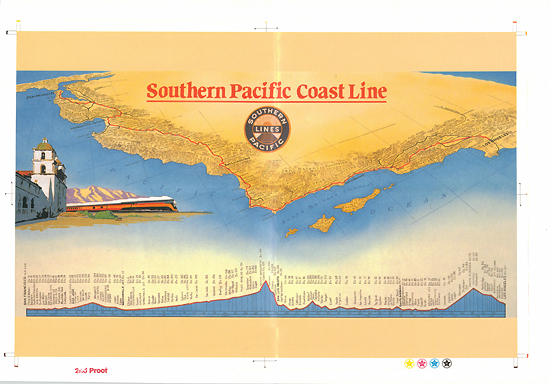
circa 1937 advertising proof from Shasta Division Archives (click on image)
Four new 1870's-1880's SP Northern Division timetables are now on the SP Maps& Timetables page.
Coast Division Local Freight Assignments, 1952-58 These are a revelation to Staff. Beyond being considerably more assignments than later, many of the job territories were quite different than those worked by Staff n the 1970's and 1980's. Model railroaders take note!
SP 1920's Peninsula electrification plans On August 27th last, we placed a link to a (large) PDF regarding SP's 1921-28 contemplations over electrification of Peninsula Commute trains, plus converting the SF to SJ line to four and six tracks. At the time we did not have the maps referenced in SP management communications, but we recently discovered and copied two of them. All of this is now on a dedicated page.
Shasta Division
We've placed 18 more vintage Shasta Division Engineering Maps online. We figure that the PDF's of more than 70 of them - mostly very large scale Station Maps - now reside on the Shasta Division Engineering Maps page.
|
| 9-18-25: More vintage SP maps |
|
Tucumcari Yard, 1929 - LARGE 1929 Engineering Department stations maps for EAST and WEST ends; by the time Wx4 staff arrived there in 1984, it was a ghost of its former self - Shasta Division Archives; see also Jawbone Dispatching Comes to Tucumcari
Six more Shasta Division Maps, including what you have been waiting for - Zuluka!
|
| 9-14-25: Addition to "The Complete Deetz"!! |
|
"The Complete Deetz" in our SP Shasta Division Engineering Maps section is now even more complete with the addition of a 1904 "Dietz" Station Map. Hold off on your celebrations, for several more Shasta Division maps will appear shortly. In the meantime, Staff anticipates being diluged with questions pertinent to this flag stop's history and evolution, many of which are already answered on the page, BTW.
|
| 9-12-25: Additional 1907-1910 SP Dumbarton Bridge & Newark Slough construction photos |
| Awhile back we posted a few photos from Shasta Division Archives, and now we have added more (total: 21), + some SP documentation - all now in PDF form. |
|
|
| 9-11-25: Some funny business |
|
YIKES! it's the Thomas ManMountain

The above Thomas the Tank Engine product certainly appears innocent enough (yes?) until one confronts the naked details. If PG discussion offends you, we suggest that you flee to the safe haven of Trains.com, rather than investigate further.
two PDF's re SSW humor and disturbing weirdness
It is Staff's experience that the best railroad humor is/was unintended to be so. Unfortunately, this is true for St. Louis Southwestern's 1950 foray into joke-making.
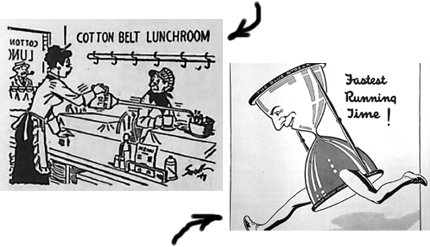
A similar bias of ours is that, in the past, railroad promotions could disturbingly weird, (an impression repeatedly born out on Wx4's Silly Johnny page - enter at your own risk). A present case in point is SSW's advertising artwork of the 1930's, such as this anthropomorphic hourglass that impresses us as a creature of Satan, albeit with nice legs. Another ad, featuring an image of Napoleon's ghost, strikes us as extolling the virtues of totalitarianism. Please consult the PDF.
|
| 9-10-25: New Miscellaneous Documents page 3 |
|
Ryan Heath has added CGW Minnesota Division dispatchers' train sheets and Milwaukee Road St. Croix Tower train sheets to his previous contributions, which now all appear together on his new Miscellaneous Documents page (Misc. Docs., page 3).
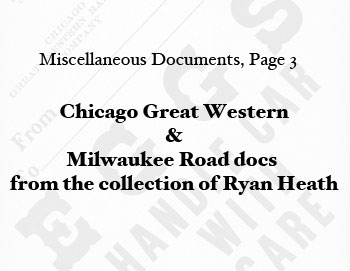
|
| 9-5-25: Paul Nobles's Southern Pacific Photos - SF Bay Area & Environs in the 70's and 80's |
Nearly 50 photos of Commutes, goats, local & through freights - don't miss his great shot of SP's little yard at Permanente.
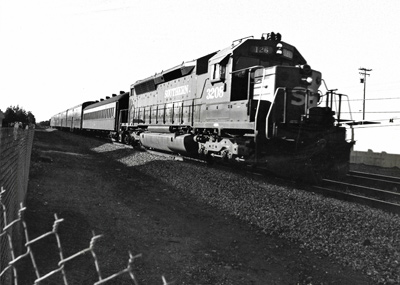
|
| 9-3-25 Santa Clara "Station Map" |
| Although SP draftsmen generated this (~8x3 feet original) drawing in 1967, it nevertheless works as an extension to the previously posted 1947 San Jose Station map. Santa Clara (a.k.a. Newhall, a.k.a. San Jose) Yard and its nearby industries -notably the canneries on the old South Pacific Coast main line alignment physically west of the depot - were at their peak in 1967.

|
| 8-27-25xxxxMore SP Miscellany |
Water depredations and/or sports:
For many years drinking water on SP locos and cabooses came from five gallon jugs perched atop water coolers that didn't cool. Then, in 1984 crews began to get sick en masse, including at Tucumcari, where I was braking at the time. Luckily for me, I managed to escape what certainly was dysentery. A fellow trainman from Los Angeles claimed that all Pacific Lines caboose water bottles were cleaned by a single LA carman. Moreover, the trainman claimed that he had personally witnessed the cleansing process: After picking up a hose end out of the surrounding mud, the carman proceeded to stuff it down the water bottle's throat to hose out the interior. If this story was not made up, it certainly explained the mini-epidemic. To me, the tale appears just too SP SOP to dismiss.
Anyway, after vociferous protests from the unions, SP began substituting six-packs of bottled water on both the cabooses and engines. Save some putrid sulphur water I drank out of a Ryegate, Montana tap 50 years ago, this was the worst H2O I have ever encountered. As bad as the bottled water was, it was a boon to bored T&E crews. Almost immediately, it was reasoned that these little (6 oz.?) bottles would make fine projectiles when heaved at crews of opposing trains. A initial host of broken windshields (in those days you could nearly fracture a windshield with a nasty glance), soon prompted perpetrators to begin removing lids before hurling their fluid greetings.
Personally, I developed a fair degree of accuracy in hitting the mark later on, thanks to practice opportunities presented by frequently passing opposing commute trains on Caltrain. I say in all humility that my hook shot was phenomenal. For awhile my wife owned a flock of laying hens that provided me with absolutely superior ammunition. My favorite recall of this was when I passed an opposing train also doing about 70 mph one evening. I managed to land a perfectly aimed splat on the opposition's windshield, which was followed by, "Caltrain #__ to the Amtrak Police! I just got egged north of Sunnyvale!", in turn followed by, "Hey Ed, did you see who did it.?" I set to laughing so hard that I almost blew my station stop at Sunnyvale. Working for the railroad was fun. - EO
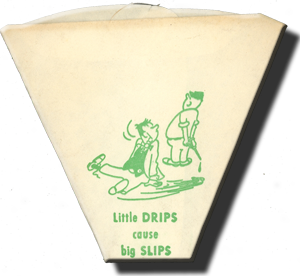
Perhaps the appropriate safety message should have read BYOB.
June 15, 1890 SP Western Div. #17 employee timetable (includes rules on reverse) - Shasta Div. Archives
REVIVED! Back in 2018, we posted Train Master era "Fleet" photos taken by a fiend of Wx4 at Third & Townsend and Visitation. We have lately discovered, however, that they had disappeared from these pages for reasons we cannot ken. Well, they are back!
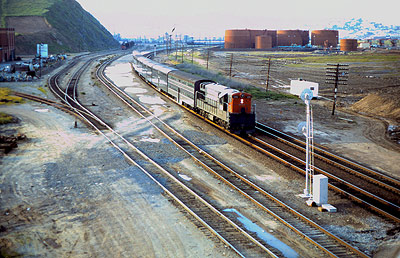
Primary source material for the serious SP historian:
Electrification, San Francisco to San Jose; Six -track railroad between Visitation and Broadway [internal correspondence] - LATE EDIT: Now on a dedicated page that includes maps referenced in the correspondence
Staff admits that we previously thought that most internal discussions over electrifying The Peninsula occurred before World War I, but no! As it turns out, a lengthy investigation took place throughout most of the 1920's, beginning with a 1921 request for same by President Wm. Sproule. During the next seven years, all manner of possibilities were contemplated that would, in the process, turn the entirety of the Peninsula run into a four-to-six track railroad. Included for awhile was a plan to run a separate freight service only double track railroad from Redwood City to Alviso and Santa Clara. The discussion appears to have ceased in 1928 after Chief Engineer George W. Boschke became "disappointed" that projected costs were "much beyond my expectation".
The above link will lead you to 120 pages of related internal company correspondence scanned at Shasta Division Archives. I have as of yet barely surveyed the pages, so should you feel compelled to comment, please do! One interesting story line that runs throughout these communications is the company's paranoia over possible encroachment onto The Peninsula by WP.
- EO
Stereopticon of SP C-1 2-8-0 #2505 at Dunsmuir Roundhouse sometime before or about 1910:
This loco became Twohy Brothers #12 in 1910, and in 1915, California & Oregon Coast #127, but saw little use, apparently because it couldn't pull worth beans. You'll find a larger copy of the below on Wx4's rather extensive California & Oregon Coast / Hobbs, Wall & Co. page.
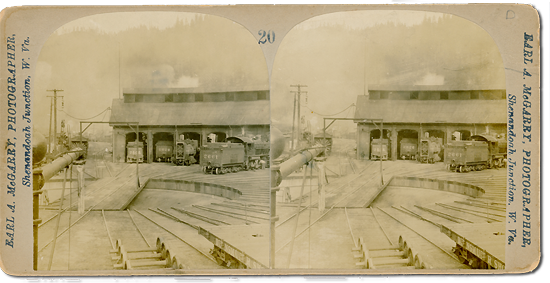
|
| 8-24-25xxxxSouthern Pacific miscellany |
|
New on the Southern Pacific Maps & Timetables page
ca 1931 Peninsular Ry. cost study with (nice) map - see also: 1933-10-10 Present Status of Branch Line Train Service (Asay)
1981-10-25 SP Los Angeles Div. rules for operations over UP,x LAUPT and AT&SF, plus a ca 1981 City of Industry SP
xxxIntermodal Terminal map
1983-02-24 Mission Bay & 4th Street Depot S.F. engineering map
1929-09-18 Tucumcari Yard - west end engineering map
1929-09-18 Tucumcari Yard - east end engineering map
1910-10-00 Coast Div. map; this and the below San Joaquin are "timetable style", but larger, with additional info
1918-06-00 San Joaquin Div. map
|
| 8-21-25xxxx1947 SP San Jose "Station Map" |
The original of this map is a postive drawing measuring ~8ft. x 3ft. and covers SP's roundhouse, "Old Yard" (next to the former Market & Basset St. arcade station site), College Park Yard (formerly the "New Yard") and the roundhouse. The map is a revision of one generated in 1911, hence neither the main yard at Newhall St. nor the depot at Cahill Street are included. The latter was called West San Jose back then, while Newhall was still 15 years in the future.
Cahill (Diridon) depot area, the wye and some of the main tracks survive today, but the rest has been obliterated. A Trader Joe's food market now sits about at the former gantry crane location in College Park Yard.
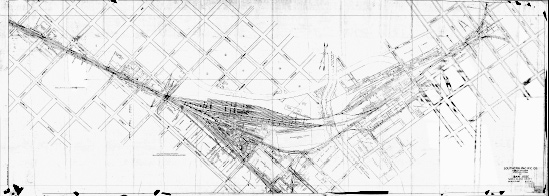
(click on the image for PDF)
|
| 8-17-25 xxxxxREWRITE! |
|
Rewritten story with additional intelligence: You are looking at Caltrain #43 - me, the rails, one of our Real Railroad Stories in the Wx4 Grab Bag (They're entirely true, as far as you know.) If nothing else, it gives us a second chance to gaze at David Rector's gorgeous photo.
|
| 8-14-25 xxxxxDoc-U-drama? |
|
BIG news! This Summer, CSRM Library has placed most of its collection of SP Employee Timetables online at Internet Archive, where it joins CSRM SP SPINS books and their complete set of SP Bulletins. Their extensive, but by no means complete ETT collection progresses from what SP termed the "New Form and Series" of 1892 through the horse blanket era all the way to 1971. We are talking thousands of timetables, here.
A few WP and Santa Fe Timetables ETT's are lately there, as well. Unfortunately, 1909-1913 SP ETT's will not be available for awhile due to the need to work around the originals' physical frailty issues. These are streaming-only files, so one can only download low resolution jpeg files by right clicking the page. Alternately, note that Wx4 still has hundreds upon hundreds of SP employee & public timetables in PDF form that can be downloaded for later perusal (many of which do not occur in the CSRM offering).
Many thanks to Jeff Asay for keeping us apprised of developments and especially, to the library's Chris Rockwell for his perserverence in getting the timetables online, despite several lumps and bumps.
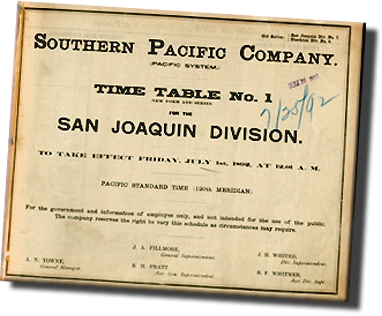
|
|
Stalwart contributor Tim Zukas has sent us 175+ more PDF files for his Maps & Timetables page: everything from Southern Pacific to Southern Ry. and a whole lot of railroads in between. Several date to the 19th Century.
Tim was the guy who really got the ETT PDF's ball rolling on Wx4 in 2016, BTW and since then several other websites blossomed with PDF offerings of their own. We like to think that Tim's work provided them with the inspiration.
Note: All Maps & TT's pages have dates of their latest additions at the top. These you can copy for insertion into your Web browser's search box.
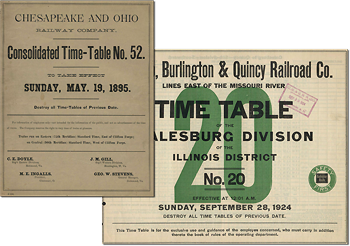
|
SP Maps
Our ongoing map scanning at the Shasta Division Archives continues to be fruitful.
First,Wx4's Shasta Division Engineering Department station maps page now has several additions, including some accompanied by Jeff Moore explanatory information on The (nearly) Complete Upton page.
Second, the Archives' Jerry Harmon has kindly supplied us with the latest permutation of his "Operating Limits and Stations of the Shasta Division" chart, which depicts his latest victories in trying to figure out N-C-O mileposts.
Third, in anticipation of increased lumber traffic on its Portland-LA, Ogden and Portland-Ogden Gateways in the future, Southern Pacific's Freight Traffic Department engaged in a 1956 Long Range Planning study to determine what sorts of physical improvements might be needed during the course of the next two decades to accommodate new business. The (weighty) results include a 213 page study, along with seven maps, all scanned at the Shasta Division Archives into PDF form. For us, we find it fascinating about how management dreams played out... or didn't.
Fourth, we have scanned 11 detailed SP maps of major California and Oregon industrial areas, circa 1916-28. The originals range upwards to a nominal 3x6 feet. Below is a clipped portion of one at much reduced scale.
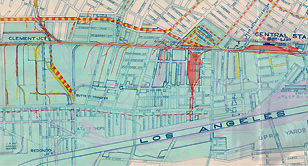
|
| Just in time for Christmas, 1887!
Let's say you were a cowboy rounding up strays near Red Bluff in December, 1887, when your foreman - Uncle Bob -, rode up to you with the news that "the railroad" [Southern Pacific] had opened up all the way to Portland, meaning that you now had a realistic way of visiting his sister, your Dear Ol' Ma, for Christmas in Ashland. Happy day! Otherwise, it was several days ride, even if you and your horse Dobbins did not succumb to hypothermia in the snowy Siskiyou Mountains. (What you did not know was that roads connecting the two states would remain primitive for another two+ decades.)
The only issue was scrounging enough cash for the train tickets. SP was apparently trying to recover its construction expenses overnight, because a round trip to Ashland would run nearly 16 bucks (2025: $530), about a month's "spending money". But, bless his heart, good old Uncle Bob, despite barely earning a buck off his hardscrabble place on Hooker Hill, came through with a Christmas bonus exactly matching the train fare.
In a few days, you would be experiencing the wonders of such places as Elmore, Chromite, Acme and Zuleka from the cozy comforts of an overheated coach. Even cowboys were entitled to a taste of luxury once in awhile.
Disambiguation. A goodly number of stations seen on the fare chart have changed their names or disappeared entirely. Acme became Black Butte, while the others have long ceased to be. Luckily for us, as previously noted Jerry Harmon has produced an "Operating Limits and Stations of the Shasta Division" chart", a working list of all known Shasta Division stations and their former names, included on Wx4's growing Shasta Division Maps page.
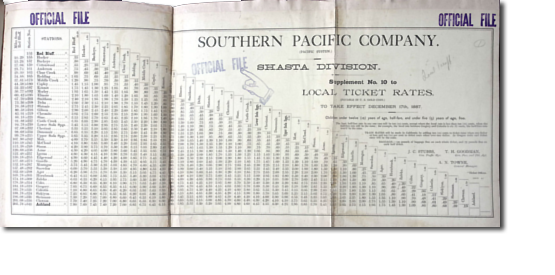
12-17-1887 Shasta Division Local Ticket Rate Chart - Note that Black Butte was originally called Acme. (click on image)
Shasta Division Archives
|
Safety Meetings, 1935
Proud of its 80% reduction in "casualties" over the previous seventeen years, Southern Pacific went to some fair expense to produce this 87 page booklet during that Depression year. A cynic would point out that the onset of dramatic reductions in deaths (only 13 in 1934!) and injuries coincided with the ultra dramatic decline in traffic that coincided with the Depression's onset, but nevermind. The company's heart was in the right place and things were definitely headed in the right direction.
Inside you'll find some basic injury stats plus a considerable number of safety essays and illustrations, reportedly cherry-picked from a large number of submissions. In all, this little booklet provides pretty good insight into the hazzards of railroading a century ago. We might add that point #5 in the accident reduction program below regarding making "Safety Meetings more interesting" most certainly generated a lot of unappreciated responses, such as "hire strippers" or "Hand out quarts of whiskey as door prizes." Each man walked his own path in regards to safety.
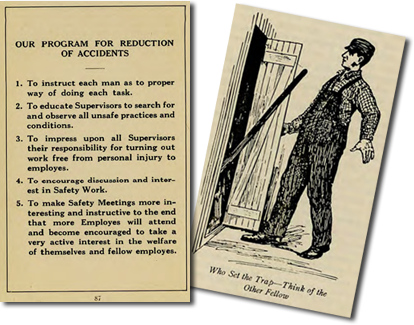
|
SP employee timebooks
Wx4's extensive collection of seniority rosters and timebooks has two new additions: a 1939 timebook of Portland Division James. F. Hendershott kindly provided by Robert Bowdidge and one that should interest SP modelers, the 1961-71 timebook of (Shasta Division?) Conductor D. W. Nichols, who exclusively worked the Cascade. What makes this one intriguing is the inclusion of the engine and car numbers for all of the consists he worked. Wanna learn when the Cascade replaced PA's with F's?
|
Central Pacific sectionmen rules
Staff is unsure of when this undated 11 page booklet was created under the auspices of W. G. Curtis, Superintendent of Track.
Online records at California State Museum tell us this about Curtis:
In 1891, the Southern Pacific Track Department and Bridges & Buildings Department were combined to form the Maintenance of Way Department. Since the Track Department was the senior department, then former Track Department head W.G. Curtis became the Engineer, Maintenance of Way and Arthur Brown, who was the Superintendent of Bridges & Buildings, became Assistant Engineer. In 1892, Brown retired and W.G. Curtis was awarded a new job title: Engineer, Assistant to General Manager and Engineer Maintenance of Way. In 1902, J. H. Wallace replaced Curtis.
We easily conclude that this booklet appeared before Curtis's appointment as Engineer, Maintenance of Way in 1891, but exactly when? Perhaps more telling about its publication date is that Wx4 already has an almost identical book put out in 1888, SP Portland to Roseburg Division Instructions to Sectionmen. There is, however just enough formatting difference between the two to suggest that they were published at different times, but not too far apart. Content-wise, they are identical.
Thus we would say that the booklet dates pretty darn close to 1888. Given their identical content, why there was not a less expensive omnibus book for all SP holdings is interesting to contemplate.
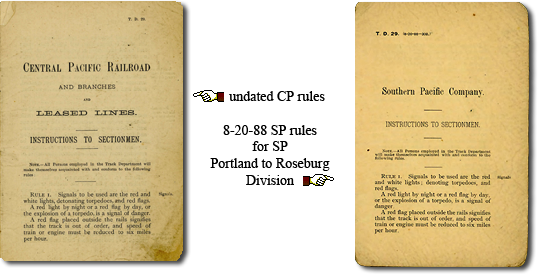
linkxxxxxxxxxxxxxxxxxxxxxxxxxxxxxxxxxxxxxxxxxxxxxxxxxxxxxxxxxxxxxxxxxxxlink
|
|
|
|
|
